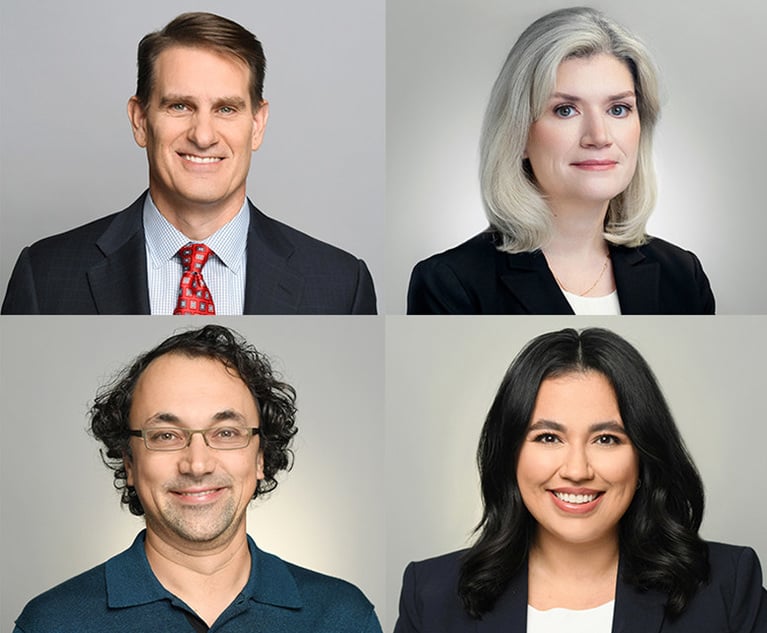 Creating an age-diverse workforce can vastly improve the knowledge, skills and productivity of your employees. (Photo: Shutterstock)
Creating an age-diverse workforce can vastly improve the knowledge, skills and productivity of your employees. (Photo: Shutterstock)Age Diversity: Risk Management's Silent Partner
U.S. government data show the number of workers aged 55 and older still on the job has increased by nearly 29% since 2012.
March 28, 2019 at 07:00 AM
7 minute read
The original version of this story was published on Law.com
Don't look now, but the workforce is aging.
According to the Bureau of Labor Statistics (BLS), workers aged 55 and older made up 22.4% of the workforce in 2016 and by 2024, are expected to make up 24.8% of the workforce. BLS data show the number of workers aged 55 and older still on the job has increased by nearly 29% since 2012.
It's a trend that will continue. According to the Society for Human Resource Management (SHRM), 10,000 baby boomers turn 65 each day. By 2020, there will be more than 31 million job openings and too few people to fill them, says a Georgetown University report, leaving a shortage of 5 million or more qualified workers.
That has caused concern among risk management departments. That's because all too often, age diversity is looked upon as a challenge for companies to overcome. Many businesses also have no idea how to address concerns regarding how older workers will team with millennials.
But such age diversity can be a huge asset to companies, particularly when it comes to employing and retaining older workers. The baby boomer generation offers companies a breadth of industry knowledge, a strong work ethic, experience working in teams, and mentorship potential. Moreover, a workforce with a widely diverse demographic can be a significant benefit to a company's risk exposure.
|The older worker bonus
However, misconceptions often get in the way. AARP data reveal that employers are concerned that older workers, among other things, lack an understanding of technology, don't adjust well to change, and are too focused on retirement.
Myth No. 1: Older workers don't adapt well to change. And yet these are the same workers who have demonstrated a career's worth of adapting to changing workplace environments. A Connecticut Department of Labor fact sheet shows that while older workers are likely to question change, they are easily adaptable once they understand the reason for change.
The bonus: The older worker brings an experienced point of view. In many cases, they've solved the very problems your company may be facing. They're adept at working through complex issues and developing sound processes that have delivered results for their employers over the years.
Myth No. 2: Older workers aren't engaged. A SHRM study shows that older workers are show greater job engagement than younger workers. An Aon Hewitt/AARP study found that 65% of workers aged 55 and older are reported to be engaged at work, compared to 58-60% of those under the age of 45. Older workers often come back to the job market post-retirement because they are looking to contribute again.
The bonus: According to the Max Planck Institute for Social Law and Social Policy, older people are more focused, less distracted, and more able to concentrate on the job they're performing. And they have a strong work ethic; a report by the Sloan Center on Aging & Work at Boston College reveals that people working past retirement age are more engaged and satisfied with their jobs.
Myth No. 3: Older workers aren't tech-savvy. Not so. A 2017 Pew Research report shows that 67% of people aged 65 or older use the internet, 34% use social media, and 42% own a smart phone. Likewise, many older workers, who were on the job when their companies first adopted today's businesses rely on.
The bonus: Companies gain deep knowledge and subject matter expertise. A BLS report shows that companies that have developed programs to utilize the talents of older workers give themselves a distinct advantage, including access to an expanded labor pool. Companies also realize built-in mentorship potential, which in itself can help them reduce risks.
|Reducing risk through experience
How exactly can an older employee mentoring a younger employee reduce risk? Some areas include:
- Ethical concerns: older workers have a deep understanding of ethical issues that can catch younger workers unaware.
- Vendor relations: experienced in working with vendors long term, your older workers can advise the younger generations on how to build and nurture relationships.
- Morale/employee issues: mentoring can help frustrated employees get help and answers. An older worker helping a colleague work through a problem can also help that colleague feel empowered. When morale is high, employee turnover is reduced.
Also, such mentoring can help younger workers become much more equipped to conduct business. Older workers can teach the younger generations the soft skills that are typically acquired through experience — how to work with a team focus; potential mistakes and how to avoid them, and; how to engage others in problem-solving.
Likewise, younger workers have plenty to teach their older colleagues. Younger workers, who are typically more technically inclined, can share new programs and methods they've discovered. Younger workers can also bring new ideas to the brainstorming sessions, and can adapt to change faster, which can inspire older workers to view things through a new lens.
Those are not the only risk-reduction benefits companies can achieve by hiring older workers. Older workers, by their mere presence, can keep companies aware of any potential age discrimination concerns, such as microtargeting — job postings and hiring practices that imply applicants should be of a certain age.
|Benefits to the business
Whether working in-house or remotely, older workers who are retirement age or older afford your company access to a larger, more skilled talent pool. By adding a remote working arrangement to the mix, you can expand your talent search to the national level, which can help your company find the right-fit skills needed to improve productivity.
Also, older workers often require little or no training to get up and running. Many have worked on the very systems your company uses, and they understand workplace behavior and company policies. If an older worker needs training, chances are it will be a minimum amount.
Then there's the cost. In many cases, older workers re-entering the job market are actually more affordable than their younger counterparts. Healthcare costs in particular are often less expensive with older workers because they don't have young dependents at home. Plus, if older workers are hired in a work-from-home position, they're more willing to work for less pay and few, if any, benefits.
The bottom line: Your company benefits. More importantly, creating an age-diverse workforce can vastly improve the knowledge, skills and productivity of your employees. By embracing and integrating an older workforce with younger workers who bring new methods and ideas to the table, you can create an unstoppable team that can bring a more comprehensive approach to your business.
Sharon Emek ([email protected]) is founder and CEO of Work At Home Vintage Experts (WAHVE), a firm that specializes in matching experienced with a company's talent requirements. These opinions are her own.
This content has been archived. It is available through our partners, LexisNexis® and Bloomberg Law.
To view this content, please continue to their sites.
Not a Lexis Subscriber?
Subscribe Now
Not a Bloomberg Law Subscriber?
Subscribe Now
NOT FOR REPRINT
© 2024 ALM Global, LLC, All Rights Reserved. Request academic re-use from www.copyright.com. All other uses, submit a request to [email protected]. For more information visit Asset & Logo Licensing.
You Might Like
View All
Saying Your Goodbyes—Ethical Obligations When Transitioning to a New Firm
5 minute read
Lost in the Legal Maze: How State Regulations Are Hindering Hemp Operators' Success
7 minute read
Trending Stories
- 1Trump's SEC Overhaul: What It Means for Big Law Capital Markets, Crypto Work
- 2Armstrong Teasdale's London Creditors Face Big Losses
- 3Texas Court Invalidates SEC’s Dealer Rule, Siding with Crypto Advocates
- 4Quinn Emanuel Has Thrived in China. Will Trump Help Boost Its Fortunes?
- 5Manufacturer Must Provide Details Surrounding Expert’s Livestreamed Inspection, Fed Court Rules
Who Got The Work
Michael G. Bongiorno, Andrew Scott Dulberg and Elizabeth E. Driscoll from Wilmer Cutler Pickering Hale and Dorr have stepped in to represent Symbotic Inc., an A.I.-enabled technology platform that focuses on increasing supply chain efficiency, and other defendants in a pending shareholder derivative lawsuit. The case, filed Oct. 2 in Massachusetts District Court by the Brown Law Firm on behalf of Stephen Austen, accuses certain officers and directors of misleading investors in regard to Symbotic's potential for margin growth by failing to disclose that the company was not equipped to timely deploy its systems or manage expenses through project delays. The case, assigned to U.S. District Judge Nathaniel M. Gorton, is 1:24-cv-12522, Austen v. Cohen et al.
Who Got The Work
Edmund Polubinski and Marie Killmond of Davis Polk & Wardwell have entered appearances for data platform software development company MongoDB and other defendants in a pending shareholder derivative lawsuit. The action, filed Oct. 7 in New York Southern District Court by the Brown Law Firm, accuses the company's directors and/or officers of falsely expressing confidence in the company’s restructuring of its sales incentive plan and downplaying the severity of decreases in its upfront commitments. The case is 1:24-cv-07594, Roy v. Ittycheria et al.
Who Got The Work
Amy O. Bruchs and Kurt F. Ellison of Michael Best & Friedrich have entered appearances for Epic Systems Corp. in a pending employment discrimination lawsuit. The suit was filed Sept. 7 in Wisconsin Western District Court by Levine Eisberner LLC and Siri & Glimstad on behalf of a project manager who claims that he was wrongfully terminated after applying for a religious exemption to the defendant's COVID-19 vaccine mandate. The case, assigned to U.S. Magistrate Judge Anita Marie Boor, is 3:24-cv-00630, Secker, Nathan v. Epic Systems Corporation.
Who Got The Work
David X. Sullivan, Thomas J. Finn and Gregory A. Hall from McCarter & English have entered appearances for Sunrun Installation Services in a pending civil rights lawsuit. The complaint was filed Sept. 4 in Connecticut District Court by attorney Robert M. Berke on behalf of former employee George Edward Steins, who was arrested and charged with employing an unregistered home improvement salesperson. The complaint alleges that had Sunrun informed the Connecticut Department of Consumer Protection that the plaintiff's employment had ended in 2017 and that he no longer held Sunrun's home improvement contractor license, he would not have been hit with charges, which were dismissed in May 2024. The case, assigned to U.S. District Judge Jeffrey A. Meyer, is 3:24-cv-01423, Steins v. Sunrun, Inc. et al.
Who Got The Work
Greenberg Traurig shareholder Joshua L. Raskin has entered an appearance for boohoo.com UK Ltd. in a pending patent infringement lawsuit. The suit, filed Sept. 3 in Texas Eastern District Court by Rozier Hardt McDonough on behalf of Alto Dynamics, asserts five patents related to an online shopping platform. The case, assigned to U.S. District Judge Rodney Gilstrap, is 2:24-cv-00719, Alto Dynamics, LLC v. boohoo.com UK Limited.
Featured Firms
Law Offices of Gary Martin Hays & Associates, P.C.
(470) 294-1674
Law Offices of Mark E. Salomone
(857) 444-6468
Smith & Hassler
(713) 739-1250







